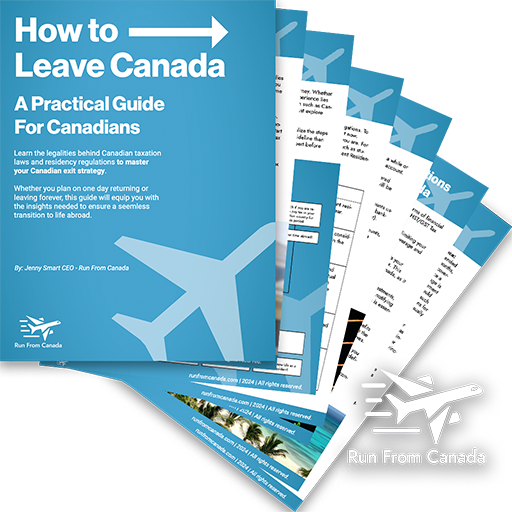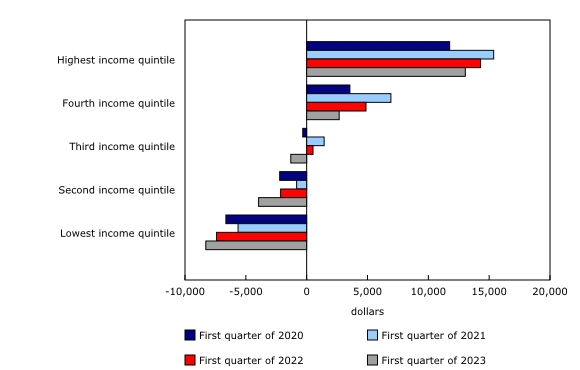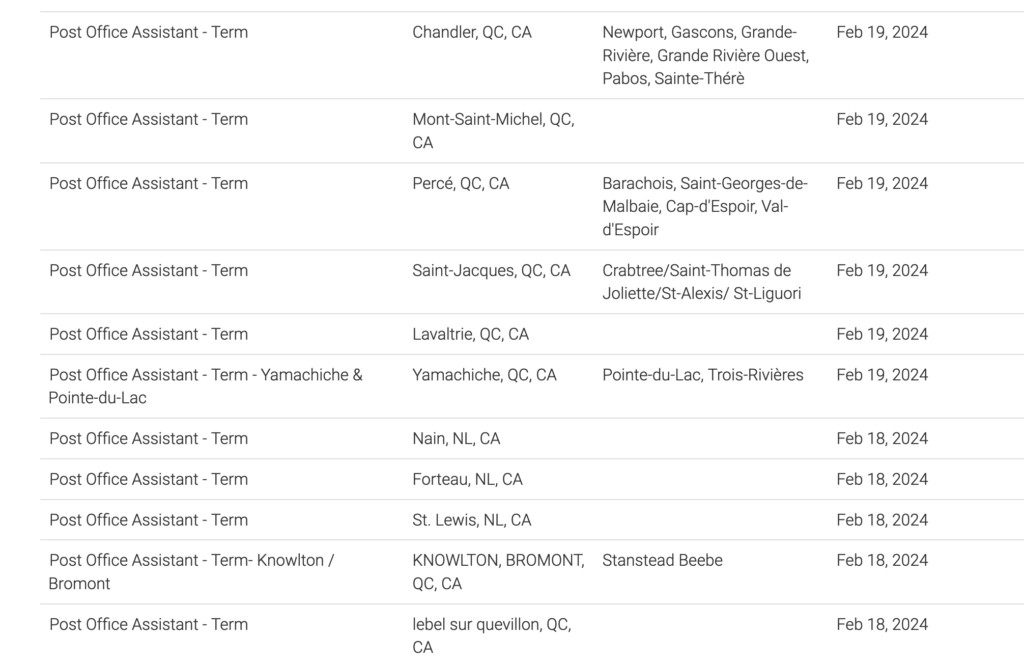Oh, Canada! Land of the maple leaf, hockey, and, as it turns out, a collapsing Canadian middle class.
The Canadian middle class is the backbone of our lovely prosperous nation, kind of like an avocado in a well-made guacamole: It’s the force that props up the economy and is a major player in the social and political stage.
So, when we see this crucial segment starting to wobble, it’s not just a blip on the radar; it’s a total nuclear meltdown.

I’m sorry to say this but in the past few years, there’s been a steady decline in the amount of people who are considered Middle Class in Canada and an increase in the amount of income and assets you need to enter this societal class. Let me show you:
In 2010 you were considered middle class in Canada if your family income would have to have surpassed: $69,860 CAD / $51,099 USD.
Now, according to Spring Financial, In 2024 to be middle class in Canada you’ll need a family income of at least $106,717 CAD / $78,058 USD.
Sadly, even though you’ve passed the six figures, you’ll still be pinching pennies and clipping coupons to maintain your socio-economic status amidst Canada’s cost of living crisis. And let’s not forget about Canada’s ungodly high taxes which create an uphill battle for moving up the prosperity ladder in this country.
It’s clear that Canadians are balancing between debt, defaults, and increasing interest rates.
And this precarious position has many Canadians eyeing the exit door, looking for opportunities abroad.
Which if you’re looking to Canada leave as well, check out our Canadian Exit Guide Here:

Say Goodbye to the Great White North!
A practical guide for Canadians looking to exit the country or leave Canada for extended periods of time.
Now let’s get back to the story. If you’re wondering about how I know the collapse in the Canadian middle class is happening it’s because I’m not just an observer with a pen; I’m part of the story!
I am middle-class expat who’s tasted the bittersweet reality of this shift. This isn’t just data and statistics; it’s personal. I know how hard it is to stay afloat in Canada’s middle-class pool.
And in this article I will use these insights to dive into the nitty-gritty of what’s shaking the foundations of our Canadian middle-class families.
Let’s find out, shall we?
What Factors are Contributing to the Middle-Class Struggle?
As you already know, the economic landscape of Canada’s middle class is a jumble of soaring costs, shrinking paychecks, and a game of musical chairs in the job (and housing) market that has left many scrambling for a seat when the music stops.
Economic Disparity Rising in Canada
First off, let’s talk about the elephant in the room: economic disparity. Since the Great Recession, the rich have been getting richer, hogging a lion’s share of the nation’s wealth, while the middle class watches their portion of the pie shrink. This isn’t just me saying it – the trends have been clear.

Average household net saving by income quintile, in CAD dollars
For instance, according the Stat’s Canada, the wealth gap in Canada has been steadily rising through the pandemic.
The data shows us that the top 40% of earners in Canada has a strong average savings rate while the lower 60% of earners income has steadily fallen and even went negative in post-pandemic Canada.
Furthermore, there’s becoming a splintering of haves and have-not’s in Canada, with the dividing line being those who own property and those who rent.
We can see this manifesting now, with the high cost of living in expensive urban hotspots like Toronto and Vancouver.
The housing market in these cities is like a rocket that’s forgotten how to land. Home-ownership? More like a distant dream, with house prices skyrocketing and renting (or tenting) becoming the new norm.
This isn’t just affecting the roof over their heads; it’s a domino effect. With more income going towards rent, saving up for a home becomes a distant dream and continues to push the middle class lower on the wealth spectrum as they have less cash for investment, education, or productive assets.
It’s no wonder there’s collapse in the Canadian middle class and many Canadians are choosing to move abroad.
Healthcare and Education Crumble in Canada
But wait, there’s more!
Healthcare, childcare, education – these aren’t just essentials; they are pillars of a stable middle class society, now bearing price tags that would make any wallet weep.
Particularly hard hit are the middle class nurses, the backbone of our broken healthcare system, who find themselves in an ironic predicament. These dedicated professionals, traditionally seen as the epitome of middle-class stability, are increasingly unable to afford living in the very cities where they are most needed.
With the cost of living skyrocketing, especially in urban areas, nurses are facing a stark reality: their salaries, once sufficient, are now failing to keep pace. This exodus of healthcare workers from major cities isn’t just a symptom of the times; it’s a glaring red flag, signaling the erosion of the middle class in Canada. As nurses struggle to make ends meet, we see the very fabric of our healthcare system starting to unravel, a foreboding sign of a society struggling to hold onto its middle-class identity.
A Precarious Employment Landscape Contributing to the Collapse in the Canadian Middle Class
And let’s not forget the precarious nature of employment in today’s Canada. Permanent, stable jobs with benefits are becoming as rare as a unicorn sighting. Check out our article on why Layoffs are exploding in Canada to learn more.
Instead, it’s a gig economy buffet – short-term contracts, freelance gigs, and part-time work without the security blanket of long-term employment.
Actually, I recently checked the Canadian Post job listings and saw a reflection of the sad job market we’re in. Being a postperson was once a full-time job with a pension, living wage and benefits.
However, now the Canada Post has replaced full time opportunities with part-time contract gigs for the majority of their positions.

This instability isn’t just stressful; it’s reshaping the middle-class landscape, making it harder for folks to plan for the future or even feel secure in their present
Amidst all this, defining the middle class itself can be as tricky as nailing jelly to a wall. The Organization For Economic Co-Operation Development (OECD) pegged about 58% of Canada as middle class back in 2019.
But pinning down what that means in terms of income is like trying to catch a slippery fish. For instance, middle-class income in Canada is thought to range between $69,359 and $106,717. But remember, this varies widely across provinces, with the cost of living in some areas making a middle-class lifestyle more expensive than in others.
So, the picture of the middle-class family with a house and two cars might not be the reality for many today, especially with home ownership rates dropping and more folks renting.
In a nutshell, the Canadian middle class is in a tough spot. It’s a cocktail of economic challenges that’s shaken, not stirred, and it’s leaving a bitter taste for many.
How New Policies Hurting the Canadian Middle Class
Canada, sweet Canada! With the middle class on shaky ground, it’s high time for our policymakers and stakeholders to step up to the plate – and they have been trying. Although the success rate my vary.
Tackling the roots of income inequality, sky-high rent, and the scarcity of good jobs is at the forefront of Canada’s political class’s agenda. And they are working on some remedies for it. Let’s take a look at them.

Enter the Housing Accelerator Fund, a bold move by the government, working tirelessly with partners across the country to slice through red tape and boost Canada’s housing supply.
Think of it as a high-speed train to nearly half a million new homes over the next decade, making student housing, rentals, and affordable housing more accessible, especially in cities.
It’s about cutting down those lengthy city council approvals to speed up development and create a diverse range of housing options.
But wait, there’s more! The in the Canadian government’s latest budget, they have also announced the roll out of a Canada-wide early learning and child care system aiming to provide $10-a-day child care. Furthering their efforts to ease stresses on the middle class.
Now, On the grocery front, it’s time to put a stop to corporate greed hiking up prices. (Yeah funny joke – we know)
The government is tripling funding for consumer advocacy groups to keep an eye on pricing policies and business practices in the grocery sector. This includes tackling issues like shrinkflation and skimpflation, ensuring Canadians aren’t paying more for less.
Also, to make life a bit more bearable for the middle class, the government has announced new measures like rent support for low-income renters and opening more emergency shelter spaces.
This includes a national top-up to the Canada Housing Benefit and a significant investment in emergency winter funding to provide more shelter spaces for those in need. These steps are part of a broader economic plan to create a more equitable and affordable living situation for all Canadians
So, what’s the bottom line? Canada is at a crossroads. To uplift the middle class, it’s crucial to tackle housing affordability, income inequality, and the cost of living head-on. By focusing on these key areas, the government can pave the way for a more prosperous and equitable future for all Canadians.
Comparing Living Standards and Opportunities in Canada vs. Abroad:
Oh, the great Canadian diaspora!
Picture this: a flock of middle-class Canucks spreading their wings and flying off to distant lands. Why, you ask? To chase better living standards and opportunities that seem just out of reach in the land of the maple leaf.
Countries like Australia, Germany, Denmark and those ever-cozy Nordic nations are rolling out the red carpet for our expats. Imagine a world where the social safety net doesn’t feel like a tightrope, where healthcare doesn’t break the bank or leave you dying in a waiting room, and where education is as accessible as a hot cup of Tim Hortons coffee.
This isn’t a fantasy; it’s what these countries offer, along with a big old slice of income equality pie.
And let’s talk about the cost of living. In these expat hotspots, your loonies and toonies stretch further. Housing? More affordable than a Toronto studio apartment. Healthcare? So accessible, you might just go for a check-up for fun. The result? More savings, less financial panic, and a life where you’re not perpetually stuck in survival mode.
In the realm of jobs, the grass seems greener on the other side. Our expatriate pals find job markets ripe with opportunities, less cutthroat competition, and an environment that values work-life balance. It’s not just about making a living; it’s about making a life.
Now, let’s bring it home with some real-life Canadian escape artists:
Take Roland Cameron, a Hamilton business owner who traded the rising tide of Canadian living costs for the sun-kissed shores of Barbados. Or Steve Thurrott, an Ottawa veteran who swapped the Great White North for Cambodia’s warmth, where a three-bedroom house with a pool costs less than a Canadian closet.
And then there’s Shane Baetz from London, Ontario. Faced with skyrocketing home prices, he packed up and moved to the Philippines, where his dollar stretches like warm mozzarella on a pizza.
These stories aren’t just about saving a few bucks. They’re tales of courage, resilience, and the pursuit of a life where the term ‘middle-class struggle’ isn’t part of the daily vocabulary. It’s about taking a leap of faith, finding new horizons, and maybe, just maybe, not having to worry about what’s left in the bank after paying the bills.
Want to take the jump like these gentlemen did? First, see which country you’ll fit in best here, with the Leaving Canada Country Matching Quiz:
Deciding to Stay or Leave a Declining Middle Class
And so, we reach the end of our Canadian middle-class saga. It’s like the final scene of a movie where the hero realizes the battle isn’t over yet. The shrinking middle class in Canada isn’t just a headline; it’s a wake-up call ringing louder than a lumberjack’s alarm clock at dawn.
This isn’t just about dollars and cents; it’s about the fabric of Canadian society fraying at the edges. The income inequality gap is widening like the mouth of the mighty Fraser River, and job opportunities are as scarce as a snow-free Canadian winter. High living costs? They’re pressing down on the middle class like a heavy snowfall on a weak roof.
The tales of Canadians jetting off to foreign lands in search of a better life are more than just anecdotes.
They’re a mosaic of resilience, a testament to the human spirit’s quest for a brighter tomorrow which you too can become a part of.
As the policymakers roll up their sleeves, it’s crucial they tune into this chorus of Canadian voices, each singing a song of struggle and hope. The path to rejuvenation lies in not just listening, but acting – creating a thriving Canada wherever you end up.
In the grand scheme of things, the dwindling middle class is the canary in the economic coal mine, signaling broader societal challenges.
It’s a call to arms for bold, innovative actions, a commitment to weave a more equitable and inclusive social fabric. By confronting the dragons of income inequality, soaring living costs, and job insecurity head-on, we can reforge the middle class, turning it into a robust, resilient backbone of the Canadian identity.
This is our moment, Canada. Let’s grab it with both hands, eh?
Looking to leave Canada?
Take the country quiz to see where you belong!


Leave a Reply